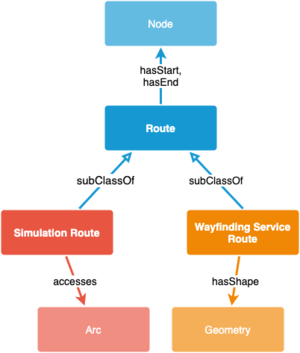Difference between revisions of "Minimum viable definition"
Megankatsumi (talk | contribs) m (Megankatsumi moved page Maximal common definition to Minimum viable definition: term change) |
Megankatsumi (talk | contribs) |
||
| Line 1: | Line 1: | ||
| − | A | + | A minimum viable definition is identified relative to a set of [[definitions]] for the same term. The minimum viable definition identifies the minimum semantics required for a term, as are shared between each definition in the set. Currently, one minimum viable definition is identified for each term in the city data model. The purpose of these definitions is to clearly identify the shared meaning that all stakeholders have in common regarding a particular term. These definitions also serve to identify the set of properties that are shared amongst each definition in the set. In the example illustrated below, Route is a minimum viable definition for the Simulation Route and Wayfinding Service Route classes. The start and end node properties are inherited from Route by both classes. Thus by way of identifying the shared semantics, the minimum viable definition also provides a clear view of the core set of properties that are common to all of the specialized definitions. Each specialized definition is identified as a subclass (or sub-property) of the minimum viable definition. |
| − | + | In the future, we may look at extending this analysis to identify pairwise maximal common definitions (i.e. to identify the semantics shared between two specialized definitions of a term). | |
| + | |||
| + | [[File:Route example.png|thumb|left]] | ||
Latest revision as of 16:43, 1 June 2020
A minimum viable definition is identified relative to a set of definitions for the same term. The minimum viable definition identifies the minimum semantics required for a term, as are shared between each definition in the set. Currently, one minimum viable definition is identified for each term in the city data model. The purpose of these definitions is to clearly identify the shared meaning that all stakeholders have in common regarding a particular term. These definitions also serve to identify the set of properties that are shared amongst each definition in the set. In the example illustrated below, Route is a minimum viable definition for the Simulation Route and Wayfinding Service Route classes. The start and end node properties are inherited from Route by both classes. Thus by way of identifying the shared semantics, the minimum viable definition also provides a clear view of the core set of properties that are common to all of the specialized definitions. Each specialized definition is identified as a subclass (or sub-property) of the minimum viable definition.
In the future, we may look at extending this analysis to identify pairwise maximal common definitions (i.e. to identify the semantics shared between two specialized definitions of a term).
